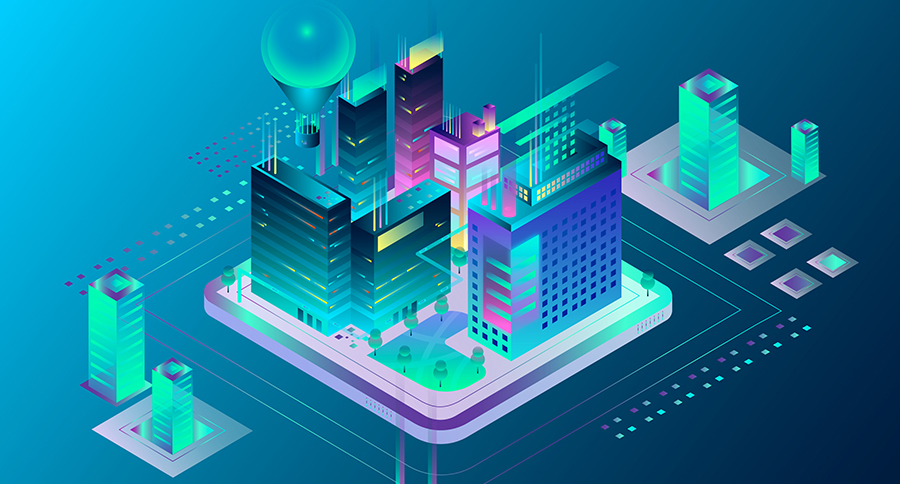
04 ม.ค. ArcGIS—The Foundation for Digital Twins
ArcGIS – พื้นฐานของ Digital Twins
เทคโนโลยี GIS เป็นเครื่องมือสำคัญในการสร้าง Digital Twins ที่ช่วยให้เห็นพื้นที่แบบองค์รวม โดย Digital Twins สามารถบอกปัญหาที่เกี่ยวกับความเข้าใจในเหตุการณ์ในอดีตของสินทรัพย์ การมอนิเตอร์ประสิทธิภาพการดำเนินงาน และการทดสอบต่าง ๆ ทั้งนี้ Digital Twins ของสินทรัพย์ถาวรหรือวัตถุทางกายภาพใด ๆ ก็ได้ รับประโยชน์โดยตรงจากข้อมูล GIS ที่รวบรวมเกี่ยวกับสินทรัพย์หรือระบบรวมทั้งบริบททางภูมิศาสตร์ของแบบจำลองนั้น เทคโนโลยี GIS ไม่ได้มีประโยชน์เพียงสร้าง Digital Twins ของธรรมชาติและที่มนุษย์สร้างขึ้นเท่านั้น แต่มันยังเป็นเทคโนโลยีที่สามารถนำไปใช้ร่วมกับแบบจำลองทางดิจิทัลอื่น ๆ ที่แตกต่างกันได้อีกด้วย
GIS เป็นเทคโนโลยีหนึ่งเดียวที่ใช้” โลเคชัน” ในการวิเคราะห์แบบจำลองข้อมูลและชุดข้อมูลอันซับซ้อน โดยเทคโนโลยี Geospatial จาก ArcGIS ซึ่งเป็นส่วนสำคัญของ Digital Twins สามารถใช้งานผ่านโมบาย เว็บเบราว์เซอร์ หรือเดสก์ท็อปแอปพลิเคชันจาก Esri และพาร์ทเนอร์ของ Esri ได้
ข้อมูล GIS ช่วยเพิ่มศักยภาพให้กับแบบจำลองเสมือน ตัวอย่างในการวิเคราะห์ที่ไม่ซับซ้อน เช่น ในการสำรวจผลกระทบของเงา (Shadow impact) บนโครงสร้างอาคารสามารถใช้ 3D GIS ในเว็บเบราว์เซอร์ที่ใช้ง่ายและว่องไว สำหรับการวิเคราะห์ที่มีความซับซ้อน เช่น การจำลองการเปลี่ยนแปลงของโครงข่ายสาธารณูปโภคขนาดใหญ่อาจใช้ Geoprocessing workflow ระดับสูงเพื่อสังเกตการเปลี่ยนแปลงผ่าน Dashboard ที่เข้าใจง่าย เป็นต้น
เทคโนโลยี GIS มีบทบาทสำคัญในการช่วยลูกค้าจำลอง วิเคราะห์ และสังเกตสินทรัพย์และระบบมานานหลายสิบปีแล้ว นอกจากนั้น เทคโนโลยีใหม่ ๆ เช่น Game engine และ Real-time data feed ต่างมีส่วนช่วยเพิ่มประสบการณ์ด้าน Interactive ให้กับผู้ใช้งานได้ใช้สำรวจและวิเคราะห์สินทรัพย์ต่าง ๆ รวมทั้งโลกรอบตัวพวกเขาด้วย
ปัจจุบัน Esri มุ่งมั่นในการลงทุนและพัฒนาเทคโนโลยีต่าง ๆ ที่สนับสนุน ArcGIS ในการสร้าง Digital Twins ให้ก้าวหน้ายิ่งขึ้น ไม่ว่าจะเป็นเทคโนโลยี Reality capture, BIM integration, Building systems integration, The analysis of IoT data รวมทั้งเทคโนโลยีและเครื่องมือที่เกี่ยวข้องอื่น ๆ
สร้างอนาคตที่ยั่งยืน
องค์กรทั่วโลกต่างจำเป็นต้องปรับโครงสร้างพื้นฐานของตนให้ทันสมัยเพื่อสร้างความยั่งยืนในอนาคต โดยจำเป็นต้องแก้ไขในสิ่งที่ล้าหลัง และเชื่อมั่นว่าเป้าหมายใหม่ที่ยั่งยืนจะเหมาะสมกับความต้องการทั้งในวันนี้ และปรับเปลี่ยนให้ลงตัวกับอนาคตได้ นั่นก็คือการปกป้องพลังงาน น้ำ การเดินทาง และเครือข่ายการสื่อสารจากภัยคุกคามต่าง ๆ และหมายรวมถึงการร่วมมือกับภาคธุรกิจ ภาครัฐ และชุมชนเพื่อนำพลังงานหมุนเวียน และพลังงานที่ยั่งยืนมาใช้มากขึ้น ปัจจุบันอุตสาหกรรมต่าง ๆ กำลังเผชิญความท้าทายมากมาย ดังนี้:
- ด้านพลังงานกำลังต้องหาวิธีปรับเปลี่ยนเครือข่ายไฟฟ้าแบบเก่าให้ทันสมัย ขณะเดียวกันก็ต้องปรับสู่การเปลี่ยนแปลงที่กำหนดโดยแหล่งผลิตไฟฟ้าแบบกระจายศูนย์ (DERs)
- อุตสาหกรรมการขนส่งกำลังดิ้นรนในการหาพลังงานทดแทนการปล่อยก๊าซคาร์บอนที่สูงด้วยการใช้พลังงานไฟฟ้าและพลังงานทดแทน
- อุตสาหกรรมน้ำกำลังเรียนรู้ด้านเครือข่ายอัจฉริยะต่าง ๆ เพื่อทำความเข้าใจและอนุรักษ์แหล่งน้ำและคุณภาพ แหล่งน้ำของโลก
- องค์กรโทรคมนาคมกำลังปรับตัวก้าวทันความต้องการของสังคมยุคใหม่ที่ให้ความสำคัญในโครงสร้างพื้นฐานด้านการสื่อสารมากพอ ๆ กับไฟฟ้าและประปา
- การรวมตัวและร่วมมือกันระหว่างองค์กรได้นิยามความสำคัญและหน้าที่ขององค์กรด้าน Architecture, Engineering, and Construction (AEC) ใหม่ เพราะเป็นองค์กรที่มีความสำคัญในการเชื่อมองค์กรต่าง ๆ เข้าไว้ด้วยกันผ่านนวัตกรรมและเทคโนโลยีที่ว่องไว
ในการสร้างความร่วมมือและสร้างความยืดหยุ่นภายในองค์กร องค์กรจำเป็นต้องมีความว่องไวและสามารถปรับเปลี่ยนได้ มีความปรองดอง และเผชิญกับการเปลี่ยนความต้องการทางธุรกิจอย่างตรงไปตรงมา ในหลายสิบปีข้างหน้าจะเกิดการก่อสร้างใหม่ ๆ ซึ่งเป็นผลมาจากการเติบโตของเมือง การลดคาร์บอนไดออกไซด์ และการแปลงไปสู่ดิจิทัล องค์กรต่าง ๆ จึงจำเป็นต้องมีกลยุทธ์เชิงภูมิศาสตร์ที่สร้างและเชื่อมโครงสร้างพื้นฐานเพื่อมุ่งไปสู่ความยั่งยืนในอนาคตทั้งพลังงาน การขนส่ง น้ำ และเครือข่ายโทรคมนาคม ซึ่งการผสานเทคโนโลยี GIS เข้ากับ Digital Twins แล้วนำมาประยุกต์ใช้ในทางภูมิศาสตร์ย่อมทำให้ล่วงรู้สภาวะแวดล้อมของทุกระบบทั้งสิ่งที่มนุษย์สร้างและธรรมชาติสร้าง
ค้นหาศักยภาพของเทคโนโลยี GIS กับการประยุกต์ใช้ในอุตสาหกรรมอื่นๆ เพิ่มเติม
